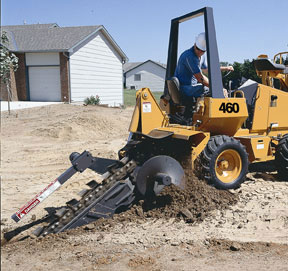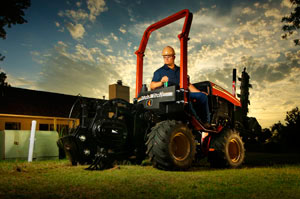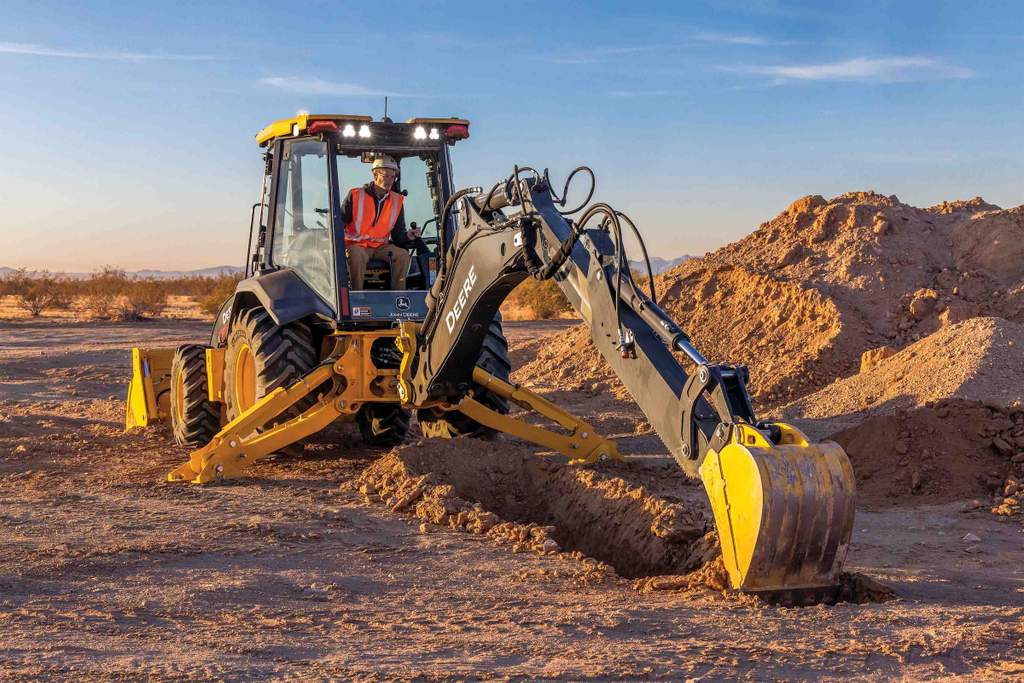Dig It
 At first glance, it looks like a giant chainsaw just drove up to the jobsite, and you half expect to see the operator donning a hockey mask and hatchet. Rolling on wheels or tracks, fitted with a long steel boom, spinning shark and alligator teeth, this ride-on trencher could probably land some menacing horror-film applications, but this monster saw is usually dedicated to cutting earth with precision and power.
At first glance, it looks like a giant chainsaw just drove up to the jobsite, and you half expect to see the operator donning a hockey mask and hatchet. Rolling on wheels or tracks, fitted with a long steel boom, spinning shark and alligator teeth, this ride-on trencher could probably land some menacing horror-film applications, but this monster saw is usually dedicated to cutting earth with precision and power.
This big trencher is actually a smaller variety of ground cutter called a compact ride-on trencher but its still able to trench depths of 4 to 6 ft and 6 to 16 in. wide with no problems. Most are powered by a 35- to 50-hp diesel engine, engineered with hydraulics to take extra attachments (like a vibratory plow or a backhoe) to add to its excavation capabilities. With a steady, dedicated trencher in your toolbox, utility contractors can successfully dig and install water, sewer, fiber, gas and other subsurface utilities, while often spearheading restoration. To top it all off, it’s a pretty simple machine to use.
It’s similar to the car or truck that you drove to the jobsite. Sit down and you’ll have a steering wheel sitting in front of you,explains Brent Bolay, trencher product manager with Ditch Witch. A lot of times, you’ll have the clutch, brake or foot throttle. On the control panel, you will have access to control for ground drive, speed and direction. Then you’ll have an attachment and hydraulic controls for attachment function purposes raise, lower and maybe shift the boom from center to right. Turn the key and you can start trenching or digging.
Since the 1950s, utility contractors, cities, rental shops and large estate owners have relied on the compact trencher as a relatively inexpensive machine choice for constant utility work. Even with the influx of digging machines like compact excavators, backhoe loaders and tool carriers with trencher attachments (skid steers and compact utility loaders), the compact trencher continues to find steady work on utility projects all over the world. That’s probably because its devotion to digging can almost always out trench a mini excavator or backhoe in specific utility applications.
The industry yields two main types of compact trenchers walk-behind/pedestrian and compact ride-on units both engineered for shorter utility runs and restrictive jobsites often encountered by urban contractors. Within those two categories, there are three main manufacturers selling compact trenchers Ditch Witch, Vermeer and Astec Underground. Ride-on trenchers are the more productive of the two categories and will be the of this article.
Compact ride-on trenchers can be a bit more expensive than their walk-behind counterparts, costing from $24,000 to $60,000, depending on horsepower and how they’re equipped. Chances are that the trio of manufacturers mentioned above has an assortment of dedicated diggers that will fit your crews and job sizes. Let’s start by digging into the details.
Trench Trends
When considering a compact ride-on trencher, size and power are often its most defining points. Horsepower is a key stat for categorizing these digging creatures, but when referring to compact, you’re also giving the end-user an identifier that it can get into and work in confined areas.
I have been around the industry for 31 years now and manufacturers still class machines mostly by horsepower,says Bob Wren, training manager at Astec Underground. Size and weight are also very important. I consider a compact machine primarily for short-run trenching and utility service installation and repairs.
The typical underground utilities we think of are probably the main products installed by a ride-on trencher, including water, gas, electric, telephone, copper installations and fiber-optic. Drainage around golf courses and irrigation in both residential and commercial areas are also growing applications.

The biggest market for compact ride-on trenchers is the rental industry probably 16 to 18 percent of all units go into that market, according to Wren. Overall, manufacturers see the market being fairly stable going into 2008, with minor adjustments reflecting what’s going on in the economy. For instance, mini excavators are doing some of the same work that the trencher is asked to do.
We still have a couple of advantages over a mini excavator, Bolay is quick to note. Our productivity is better and when we’re digging a trench, the width of that trench is matched really well to the type of material you’re putting in. They don’t move more soil than they have to.
Ride-on trencher numbers are probably going to be slightly down in 2007 with two things really affecting the industry. First, the rental market has had three years of pretty strong buying cycles, says Bolay, which means renters will likely be playing less of a role in buying new equipment. Second, the slowdown in the housing or residential construction market has been hindering some new sales opportunities.
The housing market plays a big role, yet there are a lot of utility improvements going on all the time,says Wren. The major utilities have their long range plans and cannot slow down or stop just because of a dip in housing. The work will never be done. In some areas compact excavators are infringing on the trencher market, but most of that is in congested areas with lots of products already in the ground. In the compact range, about 1,600 to 1,800 units were sold in 2006, which was a little less than in 2004 and 2005. A lot of sales still depend on the housing market and the natural growth of our country. However, our international business is really on the move.
Uncover Your Options
Compact ride-on trenchers are dedicated diggers, rolling onto the jobsite everyday to trench away. While these machines have been evolving for 50 years (since the industry was first spawned by Ditch Witch with the first 12-hp, ride-on model in 1949), compact ride-on trenchers have not changed too dramatically from older generations. Even today, these machines are similarly simple (which contractors like), but the options are growing with drive systems, tracks, cutter technologies and attachments.
Most trenchers today are utilizing hydrostatic drive, an easy-to-use transmission system that makes use of hydraulic fluid under pressure to drive the mechanics. But traditional mechanical drive is still available. It’s up to the operation, but typically hydrostatics are simpler to use, which is good for rental houses.
Nearly all compact machines today are hydrostatic,says Wren. Hydrostatic machines are easier to operate and they are just as competitive as some mechanical units. In some areas, mechanical machines may trench a little faster, but they eat parts. In today’s world, the contractor has to have reliability and productivity to be competitive.

From a features standpoint, one of the focuses that we’ve had over the last couple of years has been taking care of that operator, explains Bolay. As he climbs on that machine, and we know from the rental side of this business that there are a lot of people climbing on that machine, he wants added creature comforts, especially controls and visibility.
Side-shift boom is typically an extra feature in this size class. Because these units are already pretty maneuverable, having a dedicated center boom is the more popular choice in this compact segment, but there are some applications (like when working around a structure or other utilities) where a side-shift boom is useful.
Besides versatile booms and advanced drive systems, compact ride-on trenchers also offer the operator the use of some attachments (read more about attachments in the CE sidebar on page 26), as well as options in wheels or tracks. Much like their skid steer and track loader counterparts, a dedicated track undercarriage on a trencher offers more flotation and better traction, but it may cost more initially and have more maintenance upkeep.
Tracks are definitely more expensive because it ties into things like the drive components and the cost of the rubber tracks, which are just more expensive than using rubber tires,says Bolay. Tracks are popular, but I’m not sure they’ve grown a whole lot in the last few years. The issue of having a flat tire, well, someone can fix that. But a rubber track system requires all kinds of different maintenance and it has more complex maintenance over the long haul.
By adding these innovative options and keeping the ride-on trencher small and powerful, utility equipment companies like Ditch Witch, Vermeer and Astec have created a steady and stable marketplace for trencher construction around the world. While the market for track trenchers might be limited, the trencher market overall will no doubt grow over another half century.
If you look at the projected growth of the United States for the next 35 years, the compact utility trencher will be there to do a lot of the work, concludes Wren.





Comments are closed here.